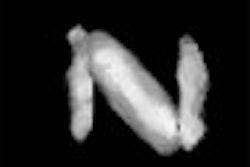
PHILADELPHIA - Inspections to measure compliance with the Mammography Quality Standards Act (MQSA) can be stressful, but proper preparation can alleviate much of the anxiety, according to Bonnie Rush, president of Breast Imaging Specialists (BIS) in San Diego.
Rush spoke during an MQSA update talk at the American Healthcare Radiology Administrator's (AHRA) Imaging Center Administrators conference, held this week in Philadelphia.
Facilities preparing for an MQSA inspection should first be sure to pick up two publications from the Food and Drug Administration (FDA): "Preparing for MQSA Inspections," which defines what the inspector will evaluate, and "Inspection Questions Under the Final Regulations," which defines the sequence of inspection questions.
"Set up your QA/QC manual in this exact order," Rush said. "Hand them the manual and go about your normal duties."
Personnel-documentation tables define acceptable documentation and the order of review, facilitating the gathering of correct documents and speeding up review at inspection time, Rush said. The requirements for initial training are based on the interpreting physicians' original qualification date, although to continue practicing, physicians all must meet the continuing requirements of education and experience based on the final MQSA regulations, she said.
Getting acquainted with your inspector
An inspector's confirmation notice provides information on who will perform the inspection, and how to contact them. If you have questions or concerns about the inspection process, call ahead to clarify, Rush said.
While inspections should not vary among inspectors, they may differ anyway, Rush said. As a result, it may be a good idea to ask a new inspector what have been the main deficiencies they've found, and to make any reasonable changes they suggest, she said.
For example, in one facility, a new inspector reported the consumer-complaint policy to be deficient, because it did not state that "all unresolved serious complaints will be reported to the ACR," Rush said. This was a correct finding, which should have been caught by the previous inspector.
Also, the new inspector reported the infection-control policy as deficient, because the information was input into a computer, instead of a log book in each room. It's not mandated, however, not to use computers, Rush said.
"Choose your disputes carefully, though, because you may have the same inspector again next year," she said.
In one case, an inspector reported a level 2 noncompliance for lack of appropriate and complete CMEs for interpreting physicians; the inspector stated that eight CME credits must be modality-specific, but accepted only seven.
The inspector indicated that the interpreting physician needed eight CME credits in screening mammography, eight in diagnostic, and eight in stereotactic (since he also performed those procedures). The inspector's ruling was incorrect, however, Rush said.
MQSA covers technologies utilizing ionizing radiation for breast imaging, including screen-film mammography (SFM) and full-field digital mammography (FFDM). There is no breakdown by screening or diagnostic applications, and the MQSA does not include biopsy techniques, Rush said.
"The inspector hadn't gone through the appropriate training to understand the dynamics of the job, and what they were supposed to be doing," Rush said. "Would you accept this level 2 violation? No, you would fight this, and you need to."
Physicians, technologists, or medical physicists who practice in mammography require initial modality training of eight hours in their modality of practice. If a facility uses both an SFM and an FFDM system, and the personnel are practicing on both systems, then they need eight hours of training for each, she said.
When adding an FFDM system, purchasers should arrange for at least eight hours of modality-specific training for all users from the vendor, Rush said.
"If not, don't buy that unit," she said.
Increased emphasis on modality continuing education is on the horizon. As of April 28, 2006, six of the 15 educational units must be in each modality of practice. This will be checked at the first inspection after that date, Rush said.
"Begin to identify and document this now," she said.
Prior to April 28, 2006, inspectors should accept 15 educational units in all subjects related to the diagnosis or treatment of breast disease or subjects that will improve the practice of mammography.
Taking exception
It's obviously wise to pick your battles. But if you do want to disagree with a finding, call your certifying agency to obtain the address to send the correspondence detailing the reason for the dispute, Rush said. The district will then contact the state and/or inspector, and within about 30 days of the original letter, the facility should receive a letter detailing the decision.
It's also important to note that states may impose more stringent mandates, which facilities must meet, she said. And state inspectors have the authority to shut down practices as part of the state inspection, unlike FDA inspectors, who can only recommend that facilities discontinue use of the equipment, personnel, or practices that resulted in the violation.
The FDA responds to repeat observations as if they were violations of the next higher level; inspectors will review the list of previous violations and will indicate a repeat violation if in the same category (e.g., mammography unit, processor, darkroom, or personnel), Rush said.
FDA inspection noncompliances are considered public record and are posted on the agency's Web site for all level 1 findings, repeat level 2 findings, or a pattern of continued violations of various types, she said.
The inspectors should give the most responsible official available the facility's inspection-results report, a cover letter depending on the maximum level finding, and verbal instructions on where to send responses. A copy to the state radiation control office must also be included, she said.
CBI
Can some violations be dealt with under the FDA's corrected before inspection (CBI) policy? Not for level 1 violations, such as if an interpreting physician is not a physician and/or is not qualified in mammography, or if the site is operating with an expired certificate, or if the phantom image score is less than three fibers, two speck groups, or two masses, Rush said.
CBI rulings are possible for level 2 and level 3 violations, in cases in which noncompliant findings were discovered and corrected before the problem worsened.
"They cannot occur at the time of the inspection as an on-the-spot correction," she said.
Facility personnel must be able to explain what actions corrected the problem, and provide documentation of the correction action. It will still be noted in the printable-remarks section of the inspection record, however, Rush said.
Also, the CBI must not have occurred at the previous inspection, since the corrective actions did not result in a permanent fix and may occur again. The CBI can't recur after the current inspection or the inspector will cite next time, she said.
Scorecard
As of September 1, facilities with a level 1 violation as the highest noncompliance level comprised 2.1% of the inspected facilities so far in 2004. Sites with the level 2 findings as the highest noncompliance level contributed 20.6%, while level 3 offenders hit 8.8%. There were no violations in 68.5% of the inspections.
A significant percentage of level 1 violations are due to lack of an effective results-communication system, Rush noted. Level 2 violations were frequently reported due to incorrect use of assessment categories, QC issues for the processor and the phantom image, or personnel records not being available or updated.
By Erik L. Ridley
AuntMinnie.com staff writer
October 4, 2004
Related Reading
Malpractice and mammography: An exam oversold?, July 15, 2004
Diligent coding means money in the bank for breast imaging, May 21, 2004
State x-ray quality assurance program yields dividends, January 23, 2004
Investigators find x-ray dose reduction varies widely among digital mammo machines, December 3, 2003
Copyright © 2004 AuntMinnie.com




















